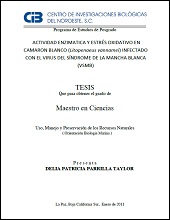| dc.contributor | TANIA ZENTENO SAVIN | |
| dc.creator | DELIA PATRICIA PARRILLA TAYLOR | |
| dc.date | 2011-01-27 | |
| dc.identifier | http://cibnor.repositorioinstitucional.mx/jspui/handle/1001/230 | |
| dc.identifier.uri | http://dspace.cibnor.mx:8080/handle/123456789/2505 | |
| dc.description | El virus del síndrome de la mancha blanca (VSMB) es considerado un patógeno extremadamente virulento que afecta la mayoría de los crustáceos en ambos hemisferios. VSMB causa estrés oxidativo debido a la producción de especies reactivas de oxígeno (ERO) como parte del sistema inmune que defiende al hospedero en contra de microorganismos extraños. Camarones de 10-12 g de peso fueron mantenidos en acuarios a 27º C, y se tomaron muestras de hemolinfa, hepatopancreas, branquias y musculo en diferentes intervalos de tiempo (1, 24 y 48 h) de camarones sanos e infectados por inyección intramuscular de un inoculo viral con VSMB. La carga viral fue confirmada y cuantificada por qPCR. Se cuantificó el daño oxidativo asociado con el estrés oxidativo (peroxidación de lípidos y carbonilos proteicos) y la actividad de (enzimas antioxidantes superoxido dismutasa (SOD), catalasa (CAT), glutatión peroxidasa (GPx), glutatión reductasa (GR) y glutatión S-transferasa (GST). Se encontró un efecto debido a la infección con VSMB en todos los tejidos y parámetros analizados. La peroxidación de lípidos y el contenido de carbonilos proteicos fue más alto en los tejidos infectados con VSMB comparado con los controles no infectados. La actividad de las enzimas antioxidantes fue significativamente más elevada a 1 h postinfección en hemolinfa, mientras que en los tejidos restantes, la actividad resultó más elevada a 24 h post-infección debido a la alta producción de ERO causada por la actividad fagocítica en contra de la infección con VSMB mientras que a 48 h postinfección se encontró un descenso de la actividad enzimática en todos los tejidos analizados. Los resultados sugieren estrés oxidativo y daño oxidativo debido a la inactivación de enzimas antioxidantes en camarones infectados con VSMB lo que da lugar al fallo del sistema y la muerte del organismo. | |
| dc.description | White spot síndrome virus (WSSV) is considered an extremely virulent pathogen that affects most of the crustaceans in both hemispheres. WSSV causes oxidative stress due to the production of ROS as part of the immune system that defends the host against foreign micro-organisms. Shrimp of 10-12 g body mass were held in aquaria at 27º C and samples of haemolymph, hepatopancreas, gills and musle were taken at different time intervals (1, 24 and 48 h) from healthy and infected shrimps by intramuscular injection with a viral inoculum of WSSV. The viral load was confirmed and cuantified by qPCR. The oxidative damage associated with oxidative stress was cuantified with the levels of oxidative damage (lipid peroxidation and carbonyl protein) and the activity of antioxidant enzymes (superoxide dismutase (SOD), catalase (CAT), glutathione peroxidase (GPx) glutathione reductase (GR) and glutathione S-transferase (GST). An effect due to the infection with WSSV was foud in all tissues and parameters analyzed. Lipid peroxidation and protein carbonyl levels were higher in WSSV-infected tissues compared to uninfected controls. The activity of antioxidant enzymes was significantly higher at 1 h post-infection in the haemolymph, while in the rest of the tissues, the activity was more elevated at 24 h post-infection due to high production of ROS caused by the phagocytic activity against infection with WSSV, while a significant reduction in antioxidant enzymes activities was found at 48 h post-infection in all the tissues analyzed. These results could indicate oxidative stress and tissue damage via inactivation of antioxidant enzymes in WSSV-infected shrimps resulting in system failure and sudden death. | |
| dc.format | application/pdf | |
| dc.language | spa | |
| dc.publisher | Centro de Investigaciones Biológicas del Noroeste, S.C. | |
| dc.rights | info:eu-repo/semantics/openAccess | |
| dc.rights | http://creativecommons.org/licenses/by-nc-nd/4.0 | |
| dc.subject | info:eu-repo/classification/AUTOR/Camarón blanco, enzimas antioxidantes, estrés oxidativo, virus del síndrome de la mancha blanca | |
| dc.subject | info:eu-repo/classification/cti/2 | |
| dc.subject | info:eu-repo/classification/cti/24 | |
| dc.subject | info:eu-repo/classification/cti/2420 | |
| dc.subject | info:eu-repo/classification/cti/242091 | |
| dc.subject | info:eu-repo/classification/cti/242091 | |
| dc.title | Actividad enzimática y estrés oxidativo en camarón blanco (Litopenaeus vannamei) infectado con el virus del síndrome de la mancha blanca (VSMB) | |
| dc.type | info:eu-repo/semantics/masterThesis | |


